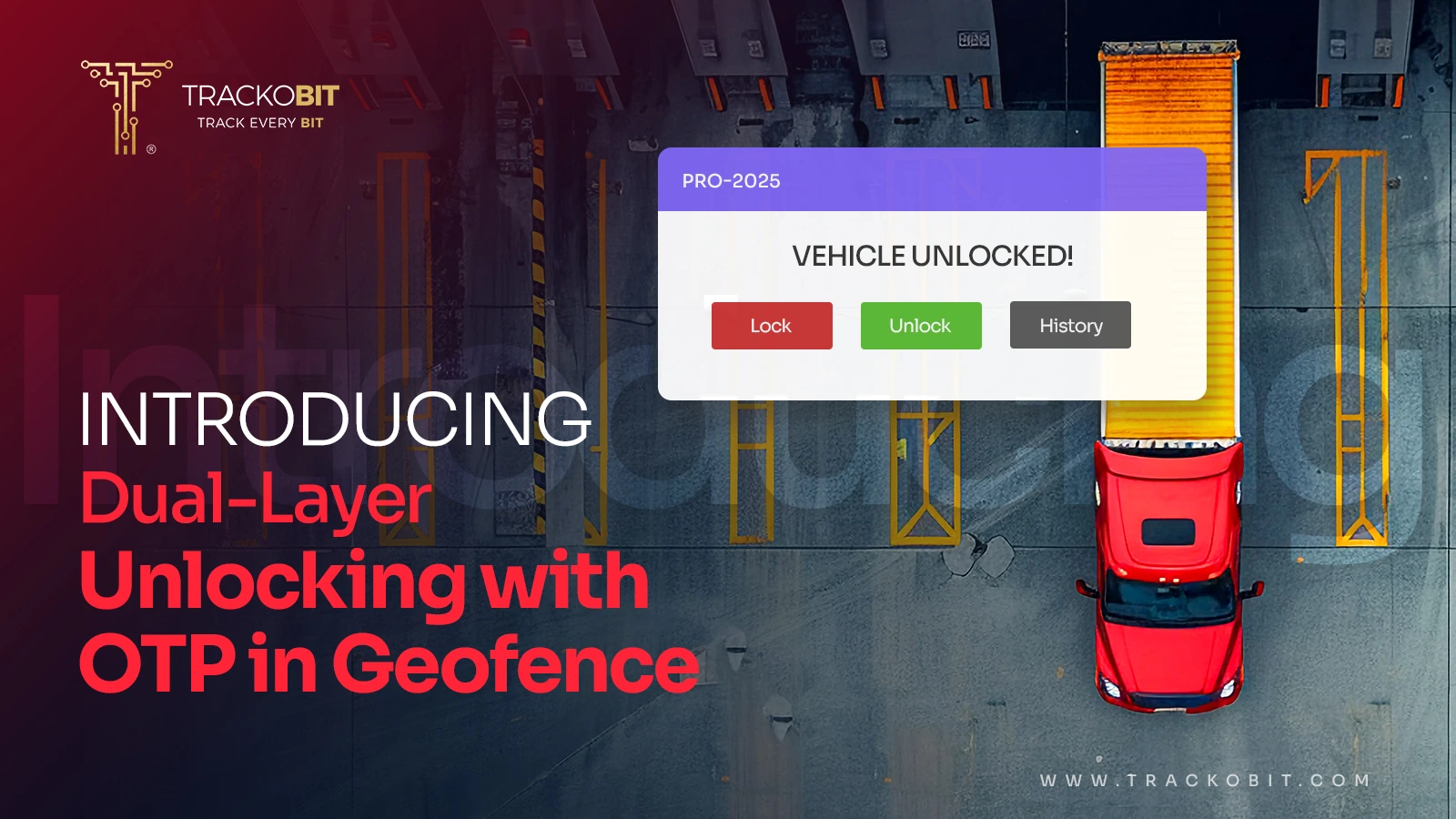-
TrackoBit
Manage commercial vehicles with the new-age Fleet Management Software
TrackoBit -
TrackoField
Streamline your scattered workforce with Field Force Management Software
TrackoField -
Features Resources
-
Blog
Carefully curated articles to update you on industrial trends. -
White Paper
Insightful papers and analysis on essential subject matters. -
Glossary
Explore an alphabetical list of relevant industry terms. -
What’s New
Get TrackoBit & TrackoField monthly updates here. -
Case Study
Explore the cases we solved with our diverse solutions. -
Comparisons
Compare platforms, features, and pricing to find your best fit.
-
About Us
Get to know TrackoBit: our team, ethos, values, and vision. -
Careers
Join the most dynamic cult of coders, creatives and changemakers. -
Tech Support
Learn about our technical support team and services in detail. -
Events
Check out the exhibitions where we left our marks and conquered. -
Contact Us
Connect with us and let us know how we can be of service.
6 Ways GPS Tracking Ensures Asset Protection
- Author:Tithi Agarwal
- Read Time:7 min
- Published:
- Last Update: January 31, 2025
Table of Contents
ToggleDiscover how GPS trackers in combination with GPS tracking software is helping you not only protect but also optimise asset utilisation in 6 ways. Let’s get rolling.
Table of Contents
Toggle
Imagining a time without GPS tracking is tough, especially for businesses. Over the years, GPS tracking has emerged as a valuable tool for tracking and protecting assets. With GPS tracking software, businesses can utilise data like real time location, asset condition and activities to improve business operations.
This article will discuss how to use GPS tracking to protect assets, types of GPS trackers and benefits.
What is GPS Asset Tracking?
With GPS asset tracking often done through software, enabled companies to track assets’ exact location and movement in real-time. Further, by pairing it with a GPS tracking system, the raw data transmitted by GPS trackers is processed into useful information such as assets’ location, speed, and direction. This is important in the case of construction machinery, cold chain cargo, delivery and more.
GPS asset tracking includes attaching GPS devices to the assets such as vehicles, cargo and heavy equipment or machinery.
Furthermore, GPS asset monitoring systems issue warnings and notifications if assets stray from their assigned routes or locations or when particular occurrences, like objects entering or departing a designated area, take place. This helps with protecting the assets and deterring theft.
| Do You Know
The market for GPS asset tracking is set to grow to over 3 billion by 2025. |
Assets Protected by GPS Tracking Software
GPS trackers not only help with locational tracking of the assets but also help stay secure about the safe transportation/transit of assets. Almost all types of assets, such as vehicles, equipment, tools, and more, can be monitored with the help of GPS asset tracking solutions. For example, in the construction industry, construction equipment, heavy machinery and other tools are managed and tracked with GPS trackers.
6 Ways How GPS Tracking Software Ensures Asset Safety
Let us understand how GPS tracking software, in combination, is helping you protect your precious assets.
1. Real-time Tracking
GPS tracking software helps locate the real-time location, movement, and whereabouts of any assets, be it vehicles, consignments, cargo, or any heavy equipment on the move. The software helps exact coordinates of whatever you’re tracking to ensure optimised utilisation and keep a check on assets’ safety round the clock.
2. ETAs & PODs
It is with the use of GPS trackers and software that you can determine the location and ETA of the assets. Asset tracking software, you can share live location tracking with customers for total visibility. This helps customers to trust you with their precious assets.
Additionally, software like TrackoBit supports multiple POD formats that authenticate consignment delivery.
3. Alerts and Notifications
Real-time alerts and notifications are a huge help when tracking and ensuring the safety of assets. You receive alerts when vehicles deviate from their assigned routes, SOS alerts, or when assets are idling.
The best part is that with TrackoBit, you get a long list of alerts to choose from, and customisation is also an option.
![]()
4. Multi-modal Tracking
Have an expensive consignment going from Haryana to Uttar Pradesh and want to ensure safety? Use GPS tracking to protect assets through multi-modal tracking. No matter how many vehicles or modes of transport come into action to drop a consignment to its destination, you’ll get regular updates on its movement.
5. Know-it-all Reports
GPS tracking system auto generates analytical reports in real time that can be diced up consignment-wise or vehicle-wise. Get detailed insights into the asset activities, performance and maintenance needs. This helps with making the right and informed decisions in a jiffy.
6. Geofencing
Set geofences on resting spots, delivery destination, and routes to know when an asset enter and exists in the virtual boundary. This helps with detecting drought deviation, idling and even asset theft.
Types of GPS Asset Trackers
- OBDII Port Device: No installation is required as it is a plug-and-play device that is inserted directly into the vehicle or other assets. This small and reasonably priced tracking device is best for fleet tracking.
- Rugged GPS Hardwired Device: An incredibly tough device is permanently hardwired into the vehicles. This tracking device provides stronger security and a lower risk of theft. Best suited for heavy machinery and motorcycles or for assets travelling in harsh terrain.
- Battery-Powered Device: With such GPS trackers, you can track possibly anything without a power supply, such as cargo containers, bicycles and more. The battery life depends on the model. The primary goal is to protect assets from getting stolen. Additionally, it allows for long-term asset tracking and theft recovery.
![]()
Features of a GPS Asset Tracking Solution
GPS asset tracking systems like TrackoBit have many features designed to help businesses manage and monitor their assets more effectively. These features include:
- Real time location tracking
- Customisable alerts
- Driver behaviour monitoring
- Historical reports
GPS tracking systems enable businesses to make data-driven decisions and optimise their resources by providing insightful information about the location, history, and usage of assets.
For example, thanks to geofencing capabilities, managers can create virtual borders around assets and get alerts when those assets enter or leave those boundaries. This increases asset utilisation and strengthens security by locating underutilised resources and maximising their deployment.
Proactive maintenance management features also enable businesses to minimise maintenance costs and maximise the efficiency of maintenance scheduling.
Conclusion
Using GPS tracking to protect assets can also help companies track and monitor asset usage. GPS asset tracking is a useful tool that helps businesses optimise their asset management and ensure their safety. It does so through real-time monitoring and tracking, proactive maintenance and geofencing.
TrackoBit is a GPS tracking software that offers accurate and real time tracking of valuable assets. It is compatible with almost all GPS tracking devices in the market. Also, it supports RFID and barcode scanning and offers elastic customisation to suit the requirements of businesses.
Frequently Asked Questions
-
How can GPS be used for protection?
GPS trackers, when paired with asset tracking software, allow managers to track the location of the assets in real time, which helps to deflect theft. A warning alert is sent if the asset is tempered without authorisation.
-
What is the difference between GPS and RFID tracking?
GPS (Global Positioning System) and RFID (Radio-Frequency Identification) tracking technologies serve distinct purposes, operating on different principles. GPS relies on a network of satellites to determine precise locations through trilateration. On the other hand, RFID uses radio-frequency electromagnetic fields for data transfer between a tag and a reader. RFID is commonly employed for short-range identification and tracking, with applications in inventory management, access control, and supply chain tracking.
-
Does GPS work without the Internet?
Yes, GPS (Global Positioning System) can work without an active internet connection. GPS relies on a network of satellites orbiting the Earth, and the GPS receiver in your device uses signals from these satellites to determine your precise location. The process involves triangulating signals from multiple satellites to calculate your latitude, longitude, and altitude.
-
How does GPS prevent car theft?
GPS devices alone cannot prevent vehicles from getting stolen. But using it in combination with GPS tracking software can help deter theft as it provides vehicle tracking, geofencing, alerts and notifications of unauthorised activity of the vehicles and recovery assistance.
-
Why do GPS trackers need SIM cards?
GPS trackers incorporate SIM cards primarily for communication purposes. These devices rely on cellular networks to transmit essential data, including real-time location information and status updates, to a central server or designated user. The SIM card facilitates access to the cellular network, enabling the GPS tracker to send data through SMS or data connections.
Tithi Agarwal is an established content marketing specialist with years of experience in Telematics and the SaaS domain. With a strong background in literature and industrial expertise in technical wr... Read More
Related Blogs
-

Plug, Pair, Perform TrackoBit Introduces BLE Sensor Integration
Tithi Agarwal November 26, 2025TrackoBit’s BLE Sensor Integration enables wireless, real-time monitoring with faster installs and accurate insights. It improves fleet efficiency, visibility, and…
-

How to Use Driver Behavior Reports as a Sales Hook to Close Big Fleets
Tithi Agarwal October 16, 2025TrackoBit’s driver behavior reports empower fleet providers to win big contracts by showcasing safety, efficiency, and measurable ROI.
-

TrackoBit’s Unlocking in Geofence with OTP: Elevating Cargo Protection
Tithi Agarwal September 16, 2025TrackoBit’s latest feature – Unlocking in Geofence with OTP lets you lock out theft and unlock cargo only at the…
-

The Rise of Electric Fleets: Challenges and Opportunities for Businesses
Tithi Agarwal September 4, 2025The global fleet landscape is poised for a decade-long transformation. This change is being powered by electricity. Logistics-led businesses are…

Subscribe for weekly tips to optimize your fleet’s potential!
Your inbox awaits a welcome email. Stay tuned for the latest blog updates & expert insights.
"While you're here, dive into some more reads or grab quick bites from our social platforms!"Stay Updated on tech, telematics and mobility. Don't miss out on the latest in the industry.
We use cookies to enhance and personalize your browsing experience. By continuing to use our website, you agree to our Privacy Policy.

































